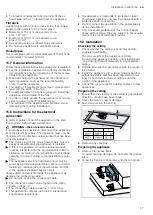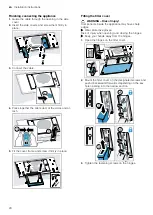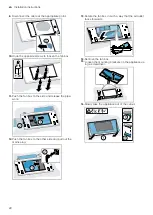
Installation instructions
en
15
15 Installation instructions
Observe this information when installing the appliance.
15.1 Included with the appliance
After unpacking all parts, check for any damage in
transit and completeness of the delivery.
15.2 Safety clearances
Comply with the safety clearances for the appliance.
≥ 200
≥ 650
≥300
≥ 1300
≥1000
15.3 Dimensions
You will find the dimensions of the appliance here
15.4 Secure installation
Follow these safety instructions when installing the ap-
pliance.
WARNING ‒ Risk of poisoning!
Risk of poisoning from flue gases being drawn back in.
Room-air-dependent heat-producing appliances (e.g.
gas, oil, wood or coal-operated heaters, continuous
flow heaters or water heaters) obtain combustion air
from the room in which they are installed and dis-
charge the exhaust gases into the open through an ex-
haust gas system (e.g. a chimney). With the extractor
hood switched on, air is extracted from the kitchen and
the adjacent rooms. Without an adequate supply of air,
the air pressure falls below atmospheric pressure.
Toxic gases from the flue or the extraction shaft are
sucked back into the living space.
▶
Always ensure adequate fresh air in the room if the
appliance is being operated in exhaust air mode at
the same time as a room air-dependent heat-produ-
cing appliance is being operated.
▶
It is only possible to safely operate the appliance if
the pressure in the room in which the heating appli-
ance is installed does not drop more than
4 Pa (0.04 mbar) below atmospheric pressure. This
can be achieved whenever the air needed for com-
bustion is able to enter through openings that can-
not be sealed, for example in doors, windows, in
conjunction with incoming/exhaust air wall boxes or
by other technical means. An incoming/exhaust air
wall box alone does not ensure compliance with the
limit.
▶
In any case, consult your responsible chimney
sweep. They are able to assess the house's entire
ventilation setup and will suggest the suitable ventil-
ation measures to you.










































